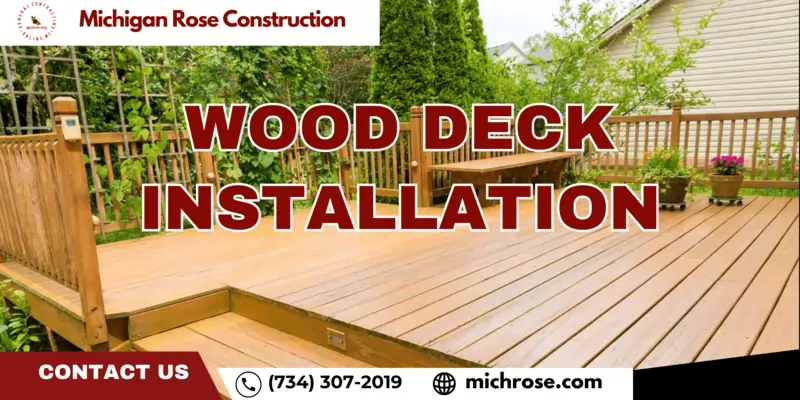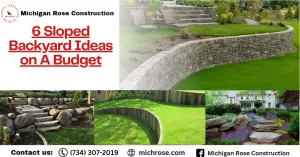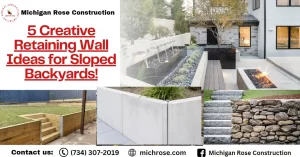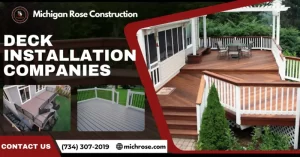Wood Deck Installation: Introduction
Decks are a popular backyard addition for Michigan homeowners. The Great Lakes State’s moderate temperatures make outdoor living spaces practical for much of the year. With its abundance of forests, Michigan has a strong tradition of woodworking and carpentry. Deck building took off in the late 20th century as an affordable way to extend living areas outdoors.
Today, wood decks remain a staple for Michigan households. They provide extra space for entertaining, relaxing, and connecting with nature. Wood decks are also attractive, eco-friendly options that can add value to homes. This guide will explore the benefits of wood decks and what Michigan homeowners need to know about deck installation. We’ll cover planning, materials, hiring contractors, building codes, and maintenance. With proper research and preparation, you can have a beautiful and functional wood deck that will serve your family for years to come.
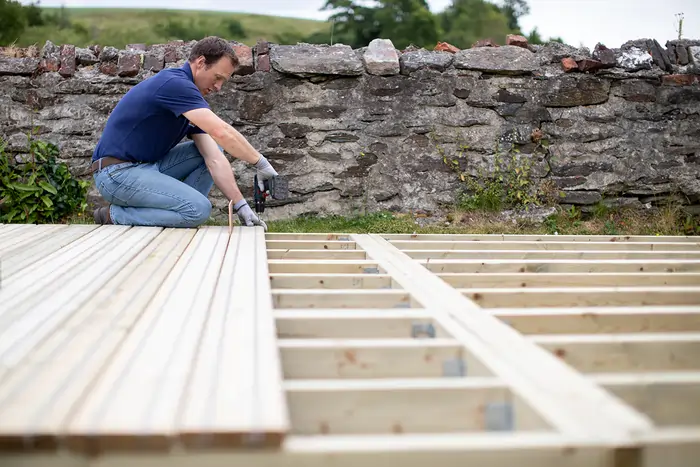
Wood Deck Installation Benefits
Wood decks are a popular outdoor living addition for many Michigan homes. There are several key benefits that make wood the top choice for deck materials:
- Natural beauty of real wood – There’s nothing quite like the rich grains and warm hues of natural wood. Unlike synthetic decking, wood offers unique natural variations in pattern, texture, and color. Real wood brings organic beauty to your outdoor space.
- Durability of wood – Wood has stood the test of time as a deck-building material. When properly maintained, a wood deck can last for decades. Hardwoods like cedar and redwood have natural rot-resistance. Pressure-treated woods are infused for longevity. Composite lumber is also durable while maintaining the look of real wood.
- Ability to stain/seal wood in different colors – One of the best things about wood decks is the ability to customize the color. Stains and seals safeguard the wood while allowing you to change its tone and hue. You can match your home’s color scheme or complement the landscape surroundings.
- Warmth of wood underfoot – Wood has a warmth and give that can’t be matched by synthetic decking materials. The natural texture of wood is more comfortable under bare feet than composite or PVC. Wood’s ability to absorb and radiate heat also enhances its livability.
Wood Deck Installation Planning
Installing a wood deck in Michigan takes careful planning and preparation. Before starting construction, you’ll want to make several key decisions:
Location
Choose a deck location that fits your property and needs. Consider backyard access, views, sunlight, and privacy. Make sure the location is feasible based on property lines, trees, and other obstacles.
Size & Shape
Think about how you plan to use your deck. Will it be for dining, relaxing, entertaining guests? This will impact ideal size and shape. Standard wood deck sizes range from 12×12 feet up to 20×20 feet or larger. Consider multiple levels or sections too.
Access Points
Determine how you’ll enter/exit the deck. Having multiple access points via stairs or ramps provides convenience and flexibility. Doorways from the home and yard gates are ideal connections.
Terrain
Account for slopes, hills, or uneven ground. This may affect post depth, step construction, and railing height on elevated decks. Proper drainage is also crucial. Consult a contractor if the terrain is highly complex.
With thoughtful planning and preparation, your dream wood deck can become a reality. Carefully considering these key factors in advance will set your deck build up for success.
Wood Deck Installation Permits Building
Installing a new wood deck or making major modifications to an existing deck requires obtaining permits in Michigan. This ensures your project follows local building codes and safety standards.
Most municipalities in Michigan require a building permit for deck construction. The permit must be obtained before work begins. The permit application will require details about the project, including:
- Size and dimensions of the deck
- Materials being used
- Site plan showing location on the property
- Construction plans and drawings
Permit applications are submitted to your local municipal building department. Larger cities like Detroit and Grand Rapids have their own building departments that handle permits. For other areas, permits are issued by the building department of the county or township.
Costs for deck permits vary by municipality but are generally $50-150 for a basic wood deck. More complex or larger decks may have higher permit fees. The permit must be posted on-site during construction.
It typically takes 2-4 weeks to receive the permit after submitting the application. The building department will review the plans to ensure they meet code requirements. Some municipalities allow online permit applications to speed up the process.
Obtaining the proper permits and having inspections done at key stages of construction ensures your deck is structurally sound and safe. It also protects you in case any issues arise down the road.
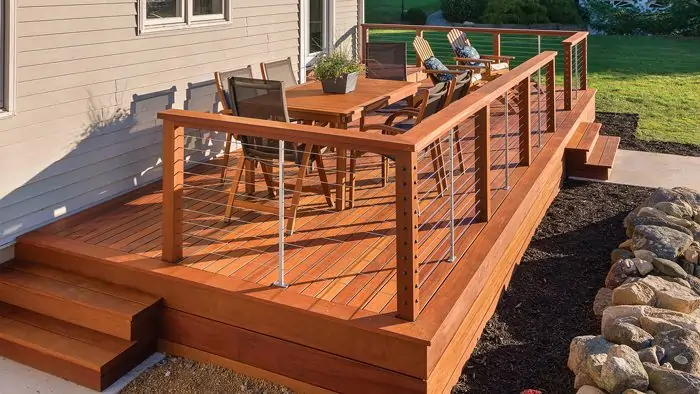
Wood Deck Installation: Choosing Decking Materials
When building a new wood deck in Michigan, you’ll need to decide which materials to use. Here are some of the main options to consider:
Types of Wood
- Pressure-treated pine is a popular choice as it’s affordable and readily available. It holds up well outdoors. Cedar and redwood are naturally rot-resistant woods but cost more.
- Hardwoods like ipe and tigerwood are very durable in all weather but are expensive. They may require pre-drilling for screws.
- Softwoods like pine are cheaper but not as strong. They need to be pressure-treated for rot resistance. Cedar and redwood have natural oils that help them last.
Composite Decking
- Composite decking is made from wood fibers and plastic. It won’t rot, warp or splinter. It holds up well to weather and foot traffic.
- Composites cost more than pressure-treated pine but require less maintenance. They come in various colors but can fade over time.
- Capped composites have a protective shell for added durability. Uncapped versions absorb more moisture.
Railings
- Wood railings match the decking but require ongoing maintenance. Opt for naturally durable woods.
- Metal and vinyl railings are low maintenance options. Aluminum and steel don’t rust. Cable railings provide an open view.
- Glass panels create contemporary railings. Tempered glass is safer if broken. Consider slip-resistance.
Hardware
- Use corrosion-resistant deck screws, nails and connectors. Look for hot-dipped galvanized or stainless steel.
- Hidden fastening systems create a smooth surface without visible screws. They allow the boards to expand and contract.
- Flashing helps prevent rot at intersections with the house. Use code-approved connectors at critical joints.
Read more: Best Deck Materials
Wood Deck Installation: Hiring a Contractor
Installing a wood deck is a complex project that requires expertise to be done properly. While ambitious DIYers may attempt to build a deck themselves, hiring a professional contractor is highly recommended for most homeowners. Here’s what you need to know about finding and working with a deck pro:
Benefits of Hiring a Professional
Pro deck builders have years of experience designing and constructing decks of all shapes, sizes, and materials. They have the skills, tools, and knowledge to:
- Accurately assess your property and design an ideal deck.
- Obtain all necessary permits and ensure the deck meets local building codes.
- Properly prepare the site and handle excavation or grading.
- Construct a sound deck frame and choose decking materials suited for the climate.
- Include important safety features like railings, stairs, and lighting.
- Finish and protect the deck with stain, sealer, or paint.
This experience virtually guarantees your satisfaction and reduces the risk of injuries, accidents, or a poorly-built deck. Professional credentials like certifications also provide peace of mind.
Finding Reputable Contractors
Ask neighbors, friends, or family for recommendations of deck builders they’ve used and liked. Search online for “deck contractors near me” and look for companies with a professional website, positive reviews, portfolio of past projects, and proper licensing and insurance.
Visit home shows to meet deck builders in person and gauge their expertise. Industry associations like NADRA also offer search tools to find certified deck professionals in your area.
Questions to Ask Prospects
Interview at least 3 deck contractor candidates and ask questions like:
- How long have you been in business? How much experience do you have?
- Are you licensed, bonded, and insured? May I see your credentials?
- What materials and brands do you use?
- Do you handle securing permits?
- What is your typical process and timeline?
- Can I see photos of decks you’ve built? May I have 3 client references?
- What warranty do you provide on workmanship? What does it cover?
- Do you have a written contract and final estimate for the project?
Their responses will help you assess their reputation, professionalism, and fit for the job.
Estimating Project Costs
Deck builders will provide a free estimate after reviewing your plans and assessing the site. Expect to pay anywhere from $25-100 per square foot for a professionally built wood deck. Get at least 3 bids to compare.
The final cost will depend on the deck size, materials, complexity of design, site conditions, and labor. Ask what is included and watch for hidden fees. A clear contract locks in the final price.
With proper planning and an experienced deck pro, you can enjoy your new outdoor living space worry-free!
See: Deck Installation Companies
Wood Deck Installation: Preparing the Site
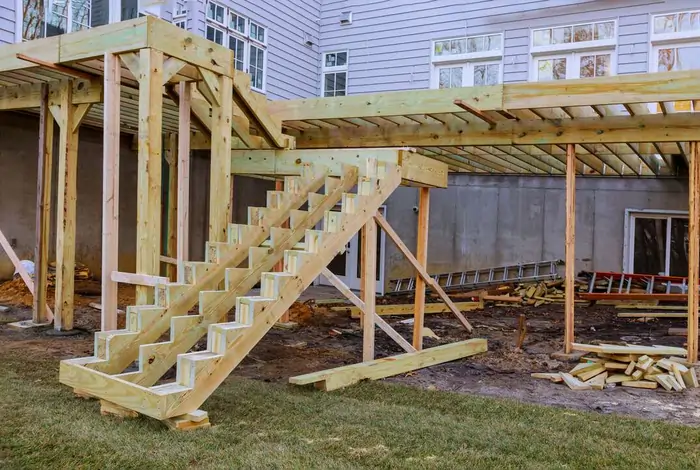
Before starting construction on your new wood deck, the site needs to be properly prepared. This involves a few key steps:
Clearing the Area
The first step is to clear the area where you plan to build the deck. Remove any grass, plants, rocks or other debris. You’ll want a flat bare surface to work with. Use a sod cutter if needed to peel up grass and roots.
Grading
Once cleared, the site may need to be graded or leveled. You want the ground beneath the deck to be flat and even. This provides stability and helps prevent settling issues. Use a transit level to identify any high or low spots. Fill in low areas with compactable fill dirt.
Installation of Footings
Footings provide the foundation for the deck. Dig holes for concrete footings based on the deck plans. The footing depth depends on frost line and local building codes, but may need to be 42-48 inches deep. Pour concrete into the footing holes and allow to fully cure before building on top.
Properly preparing the installation site is a crucial first step to ensure your wood deck has a solid base and will last for years to come. Taking the time to clear, grade and install proper footings prevents future problems down the road.
Wood Deck Installation: Framing and Decking
Framing the substructure for your deck is one of the most important parts of the installation process. This provides the underlying support system and foundation for the deck boards. Most residential decks use a simple frame made from pressure-treated lumber consisting of joists supported by beams and posts.
- Joists are spaced 16 inches on center and supported underneath by beams running perpendicular to them. Beams transfer weight to the posts which are embedded in concrete footings below ground level.
- Joists are typically 2×8, 2×10, or 2×12 lumber depending on the deck size and design. Beam size varies as well.
- It’s critical that the frame is level and properly supported. Consult building codes for specifics on structural requirements.
Once the framing is complete, you can move on to installing the decking boards. Most decks use 5/4 pressure-treated boards, redwood, cedar, or composite decking. Stagger the end joints between rows and leave a 1/8-inch gap between boards to allow for expansion. Use hidden fasteners or exterior screws to attach the boards to the joists below.
Railings and stairs are also constructed as part of the framing process. Railings typically have 4×4 posts with 2×4 balusters spaced less than 4 inches apart for safety. Stairs require framing stringers secured to the deck frame along with treads and risers cut to size. Building code requirements apply to stair dimensions.
Wood Deck Installation Finishing Touches
Adding those final details and decorative touches can really make your new wood deck shine. Here are some ideas for finishing touches:
Staining/Sealing
- Apply a waterproof deck stain or sealer to protect the wood from weathering and extend its life. Consider a semi-transparent stain which shows off the wood grain.
- Let the deck dry fully before staining, at least 24-48 hours.
- Use a brush or roller to apply the stain evenly across the boards. Maintain a wet edge and work in sections.
- Allow the stain to dry fully before using the deck, usually 24-48 hours.
- Reapply stain or sealer every 1-2 years for optimal protection.
Adding Lighting
- Install deck lighting to use your deck in the evenings. Go with solar lights or low voltage lighting.
- Place step lights on stairs for safety. Add post cap lights on deck posts or rail lighting.
- For ambience, use string lights, lanterns or spotlights focused on plants. Use a dimmer for adjustable brightness.
Furniture/Planters
- Add comfy, weather-resistant deck furniture like chairs, lounges, tables, and benches. Consider cushions.
- Use decorative planters, pots, or built-in plant boxes to add greenery and color. Grow flowers, herbs, or veggies.
- Incorporate an outdoor rug for softness and to define a sitting area. Use weatherproof mats or rugs.
- Display container gardens, sculptures, wind chimes, and other accessories to personalize your space.
Wood Deck Installation: Maintaining Your Wood Deck
A wood deck is an investment that requires ongoing maintenance. With proper care, your deck can provide enjoyment for decades. Here are some tips for keeping your wood deck in top shape:
Yearly Cleaning and Sealing
- Use a power washer or stiff brush to remove dirt, mildew, and old sealant once a year. Allow the deck to dry completely before resealing.
- Apply a fresh coat of water-repellent sealant each year. Look for a sealant that protects against UV rays and mildew. Follow the manufacturer’s application instructions.
- Inspect boards for cracking, warping, or rot each time you clean the deck. Replace damaged boards to maintain structural integrity.
Repairs as Needed
- Loose nails, screws, or splinters should be promptly repaired to prevent further issues. Use corrosion-resistant decking screws.
- Inspect railings, steps, and supports. Repair or replace components that are loose, rotten, or damaged. This helps prevent injuries.
- Fill any cracks between boards with exterior wood filler. Smooth the filler before resealing the deck.
Safety Checks
- Check for sharp edges, protruding nails, and splinters along the deck and railings. Sand down or replace hazardous areas.
- Ensure railings are firmly attached and inspect for areas of deterioration. Proper railings help prevent falls.
- Examine the structural integrity of posts, joists, beams and foundation. Reinforce or replace components as needed.
- Make sure stairs have even risers and smooth, grippy treads. Repair issues right away.
With regular maintenance and care, your wood deck can stay safe and look beautiful for many years of relaxation and entertaining outdoors!
Spruce Up Your Backyard with a Dream Deck!
Michigan Rose Construction can transform your backyard into an extension of your living space with a beautiful, custom wood deck.
Call us today (734) 307-2019 for a free consultation!
Our expert team specializes in wood deck repair and deck restoration to bring your deck back to life. Whether it’s minor repairs or a complete restoration, we’re here to help.
Don’t wait to enjoy the outdoors this summer! Contact Michigan Rose Construction today and let’s get started building your dream deck.
For more details, visit Michigan Rose Construction Facebook Page

